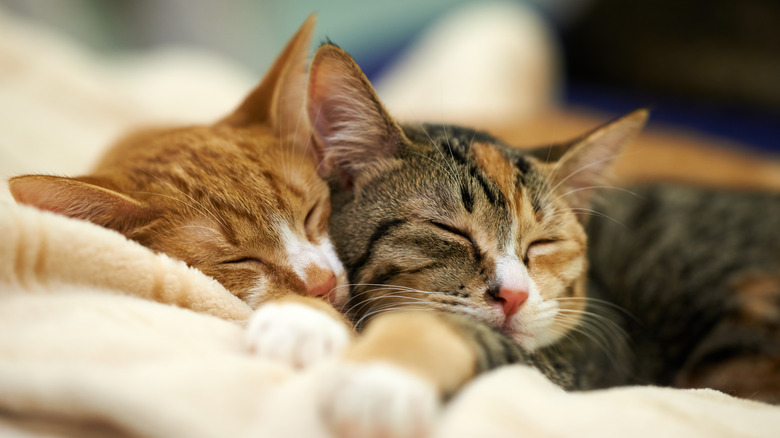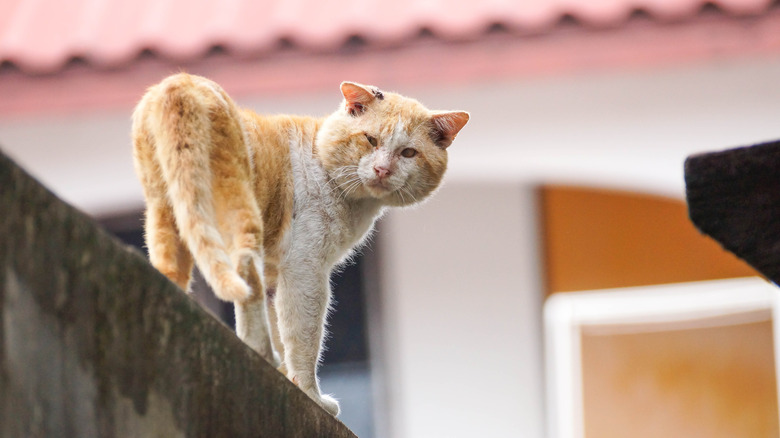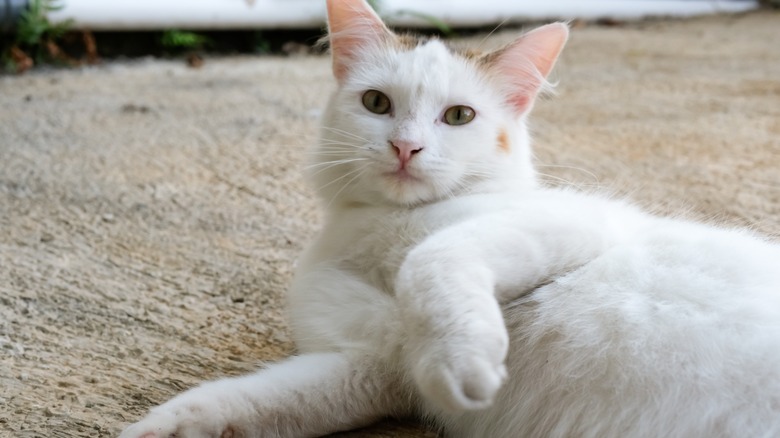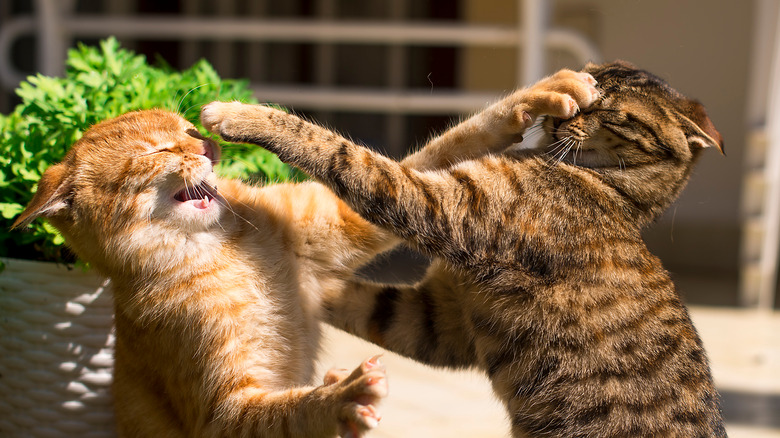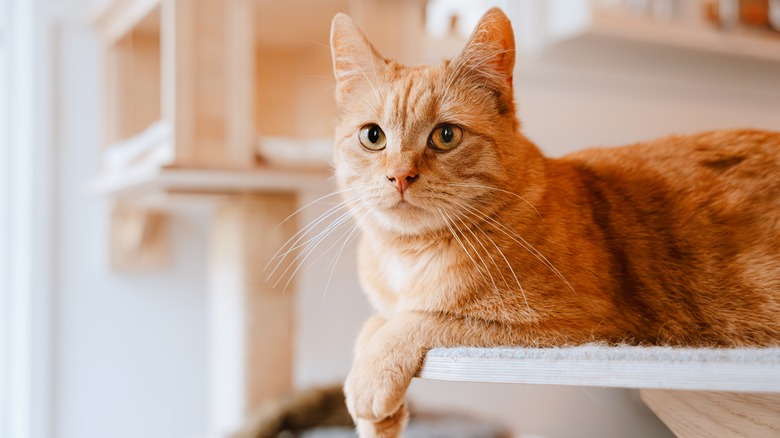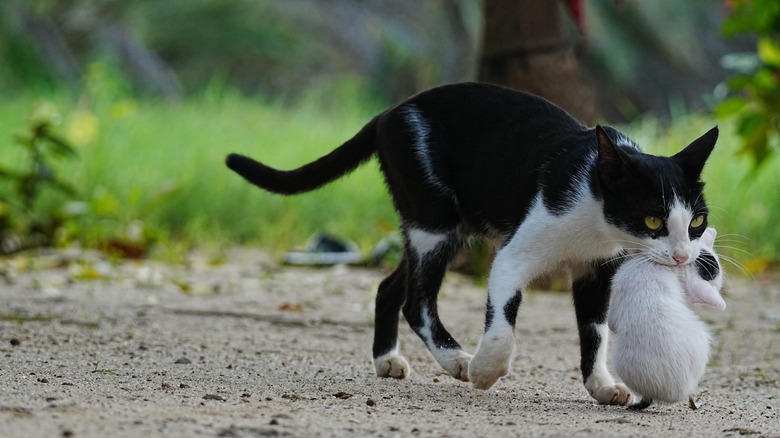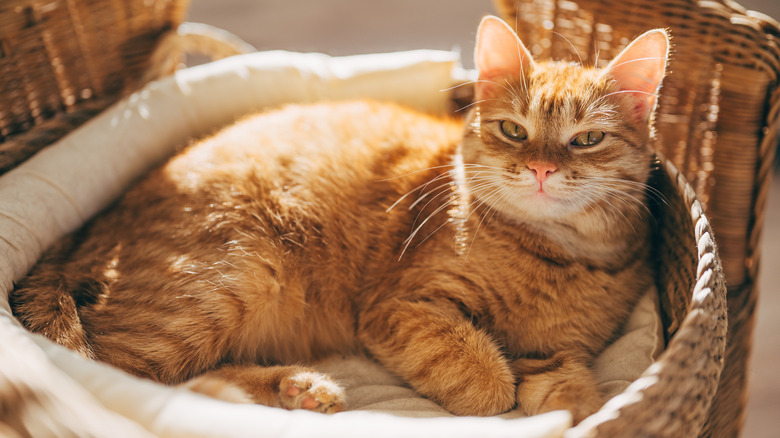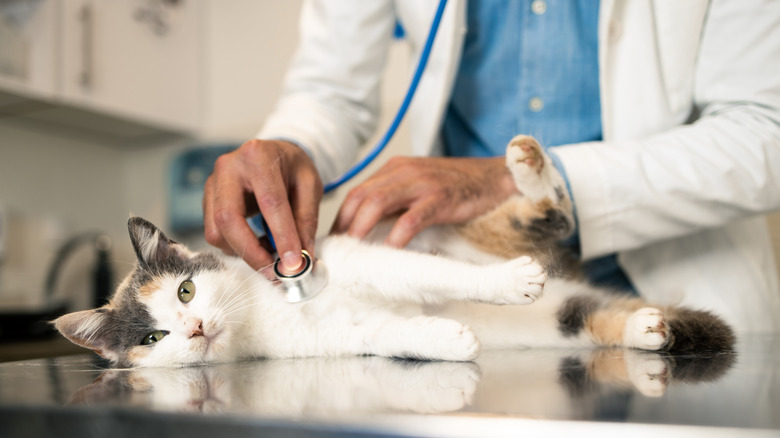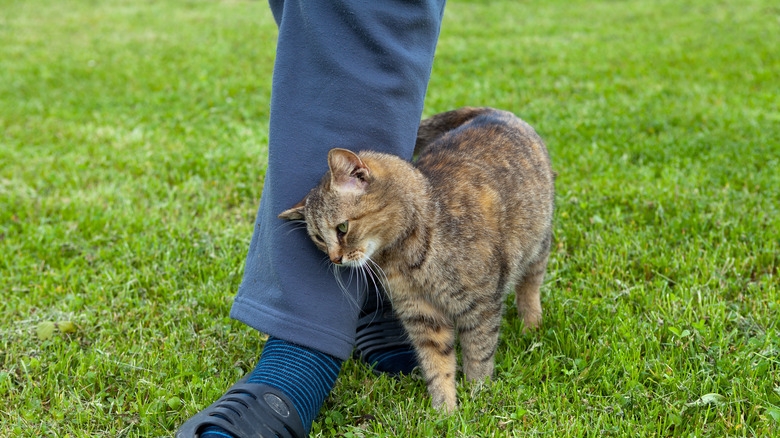The 12 Biggest Differences Between Male And Female Cats
Ask any experienced cat owner, and they'll swear that there are many key differences between male and female cats. For instance, it's widely believed that male cats are more affectionate than females. Many also believe that females are better hunters than males; when caring for kittens, they must be. But is there any scientific basis to these lines of reasoning? To some extent, yes. Sex hormones influence many aspects of a cat's development, temperament, and activity levels. It's one of the many reasons why cat owners spay and neuter their pets. Among other things, these procedures tend to "mellow out" cats and prevent the risk of health complications.
Regardless, whether you get a male or female cat, note that a feline's personality depends on its individual disposition, not its breed, age, or gender. Other factors, such as socialization, training, and the bond you share with your pet, play a much bigger role in shaping your cat's characteristics. Still, by understanding the differences between male and female felines, you can select a furry friend that meets your expectations and lifestyle.
1. Male cats are generally larger than females
Males are typically larger than female cats -– but not by much. Breed plays a role in the size discrepancy between cats. For example, Siamese cats generally weigh between 8 to 15 pounds. A male will likely average between 11 to 15 pounds, while females usually weigh 8 to 12 pounds. A few pounds can make a big difference. While a 15-pound female Siamese may be considered overweight, this poundage could be perfectly acceptable for a male.
Aside from weight, male cats may also have larger proportions than females. Toms may sport hard, fleshy jowls on both sides of their face, resembling hamsters with their cheeks stuffed. High levels of testosterone during a male cat's developmental period cause these growths, which will remain even if the tom is eventually neutered. Sometimes called "tomcat cheeks," these swollen jowls offer protection during skirmishes for mating rights, and they also signal availability to interested females.
If a neutered male cat develops tomcat cheeks later in life, this could point to an underlying medical condition, such as feline lymphoma. Whenever you notice changes in your cat's health, appearance, or behavior, always consult a trusted veterinarian. The sooner you catch medical problems in your feline, the sooner they can get the necessary treatment.
2. Tomcats are always ready to mate; queens have seasonal cycles
Tomcats are always ready to breed with female cats, and they have voracious sexual appetites. An outdoor tomcat will mate with as many females as his body will physically allow, which largely depends on his age and stamina. This always-ready-to-go attitude is one of the many reasons why feline experts advise against keeping outdoor cats; tomcats contribute to overpopulation in both shelters and on the streets.
Queens are receptive to mating during certain parts of the year, especially during the spring and summer when there's plenty of daylight. A queen will be "in heat" for two to three weeks, during which time she'll vocalize more, become more affectionate, and attempt to get outdoors to reach tomcats. A queen can have multiple litters in a single year, and multiple kittens within litters can have multiple fathers.
A spayed female cat will not be interested in mating and therefore would not be receptive to a tomcat's advances. Neutered males are not able to sire kittens and would have no interest in mating. Theoretically, you could have a tomcat and spayed female (or queen and neutered male) in the same household with no complications. Still, there are many benefits to spaying and neutering cats, such as the prevention of certain health problems, so consider discussing the procedure with your veterinarian.
3. Queens are more aggressive than spayed females and unneutered males
A 2009 study published in Applied Animal Behaviour Science examined the behavior of 336 cats that visited the Barcelona School of Veterinary Medicine over an 8-year period. The most common behavioral problems that owners reported were aggression and improper elimination (i.e., defecating outside of the litter box). The research reached a few illuminating conclusions about cat temperament across different breeds and spayed/neutered status.
A major takeaway was that queens are more aggressive than neutered females. Outdoor cats were also more prone to aggression than indoor cats, and feline aggression was more prevalent in single-cat households. Under these parameters, an unspayed cat with outdoor access would be more likely to be aggressive than, say, a spayed indoor cat.
There are many theories about why queens are prone to aggression. One is that they must be naturally on guard to protect their kittens. Another theory is that hormones can cause mood changes that make them more on guard. While the study sheds a fascinating light on cat behavior, it's not a commentary on every unspayed female cat. There are many loving, good-tempered queens in need of loving homes!
4. Female cats generally live longer than males
On average, cats live about 15 years. Yet, spayed female cats tend to live longer than male cats. But why? Spayed female cats are less likely to engage in risky behavior than tomcats.
An intact male will do everything possible to escape the household and mate with a receptive female, from squeezing through doorways to unlatching windows. Attempts to escape can increase the risk of injury in and of itself. It also elevates the likelihood of the cat suffering high-rise syndrome, an umbrella term referring to injuries suffered by cats falling from more than two stories.
Even with a successful escape, a tomcat may encounter many dangers while on the prowl for females. These hazards could include motor traffic, fights with rival males, or disease transmission. One transmissible disease is feline leukemia virus (FeLV), a common infection that suppresses the immune system. You can help your cat live a long, healthy life by keeping them indoors, which will minimize the risk of trauma. You should also consider spaying or neutering them, as this goes a long way in preventing diseases of the reproductive system.
5. Female felines respond differently to distressed kittens
Male and female cats have very different relationships with their kittens. A mother cat will tend to her kittens' every need for the first month, from grooming to helping with waste elimination. Because of their strong bond, she'll develop a discerning ear for the various sounds her kittens make. More specifically, she can tell the difference between a playful chirp and a cry for help.
A study published in BMC Evolutionary Biology revealed that female cats respond faster to kittens in a highly aroused state than those in a lower state of arousal. It didn't matter whether the female kittens were mothers or not; they all had a similar response to kittens possibly in distress. The reason is likely because feral female cats raise their young in colonies, communally taking part in caretaking roles.
The same report showed that while male cats respond to kittens' calls, they do not adjust their response time based on urgency. This isn't because male cats are less caring or "hate" kittens; it's thought that they simply can't tell the difference between kittens' sounds. Female cats are just more attuned to kittens' needs, allowing them to offer individualized care and prepare them for survival.
6. Orange cats are more likely to be male than female
Garfield. Puss in boots. Tony the Tiger. What do these cats all have in common? They're orange. They're also all male, and there's actually a scientific reason for that. Without getting too technical, cats have two chromosomes that determine their biological sex. Males have XY chromosomes, and females have XX chromosomes. For a male cat to be orange, he only needs the "ginger gene" on his X chromosome; a female needs it on both. Consequently, 8 out of 10 orange cats are male.
Here's a deeper dive into the differences between orange male and female cats. The journal Proceedings B shares that this coloration translates into a large size disparity between males and females. For instance, orange female cats generally weigh less than non-orange felines. On the other hand, orange male cats are generally heavier than their non-orange counterparts. Perhaps this is why many cartoon fat cats are orange! If you have an orange tabby, ensure you're feeding it the right amount to prevent obesity and the secondary conditions it causes. A well-balanced diet promotes your felines' well-being, whether they're orange, black, or any other color.
7. Owners report male cats as more affectionate than females
It's tough to measure something subjective like the affection of male versus female cats. So researchers who shared their findings in Frontiers in Veterinary Science decided to do the next best thing: survey cat owners with young children. The questionnaire asked participants to disclose information about their felines' sex, spayed/neutered status, and most of all, relationship with their kids.
The results showed that participants rated male cats as more affectionate than females. Further data showed that young cats appeared more bonded to their owners, and ragdolls had the most loving breed characteristics overall. With this logic, a young, male ragdoll kitten would be the most affectionate cat. While this information offers an interesting window into cat-human dynamics, it's not intended to make the blanket statement: "Male cats are more affectionate than females."
Everything about a feline's characteristics boils down to its individual experiences, temperament, and environment. Many of these things lie in the hands of humans. Cultivating a welcoming, warm home where your cat feels safe can build trust and strengthen your relationship, regardless of whether it's male or female. This involves respecting their boundaries, relying on positive reinforcement, and playing regularly.
8. Male and female cats can experience sex-specific health conditions
Spaying and neutering procedures do more than prevent unwanted litters; they also significantly reduce the likelihood of reproduction-related health conditions. For instance, neutering involves removing a male cat's testicles, eliminating the risk of testicular cancer. Removing a female cat's reproductive system can also prevent mammary and ovarian cancers. It also protects her from the complications arising from having litter after litter of kittens.
Aside from cancer, there are other conditions that spaying/neutering can prevent. For male cats, these include priapism (a persistent erection), cryptorchidism (when both testicles fail to descend upon maturity), and prostate disorders. Spaying prevents the development of mammary hypertrophy (overgrown mammary tissue), bacterial uterine infections, and dystocia (an abnormal or difficult delivery).
There are many misconceptions about spaying and neutering cats. Neutering your male cat will not make him less "masculine"; he will still retain his quirks and overall disposition. Spaying is also not a painful, traumatizing ordeal for female cats. Your veterinarian will recommend a well-balanced aftercare plan that manages your feline's comfort during her recovery. Without complications, within two weeks, she'll be back to her usual activities.
9. Female cats are reported as more demanding than males
While studying behavioral differences between male and female cats, researchers who shared their findings in Frontiers in Veterinary Science discovered that among 865 cat owners surveyed, a substantial number reported that they found female cats to be more demanding than males; however, males were more affectionate in their need for attention. There are a few possible reasons for this finding.
For starters, many people view female cats through a biased lens that may automatically attribute certain characteristics, such as being needy or fickle. It's also worth noting that unspayed female cats may have mood fluctuations while in heat, such as becoming more affectionate or yowling to get their owners' attention. A final reason why female cats could be perceived as demanding is that some are inherently demanding by nature. Some owners report that certain breeds, such as Siamese and Burmese cats, are known for being so attached that it may cross the line into separation anxiety.
Being demanding is a trait that would well serve a feral female cat, as assertiveness would allow her to become a skilled hunter, provide for her kittens, and protect her territory. It's important to note that not all female cats are demanding or need constant attention from their owners. As with many characteristics, a cat's disposition will ultimately depend on many unique circumstances.
10. Male and female cats have different playing styles
There's no doubt that some cats love to play. However, when it comes to methods, male and female cats have their preferences. A 2023 study in Scientific Reports shares that females are much more likely to engage in "chase play", simulating how they would naturally pursue prey in the wild. Females (both spayed and intact) enjoy honing their hunting prowess, and it's one of many reasons why some people believe that female cats are better hunters than males.
The same study reported two facts about male cats. First, they aren't as inclined to chase play as their female counterparts. Instead, they often partake in wrestling-like activity, which may manifest as rolling on the ground, batting without extended nails, and playful biting. For many male cats, wrestling is a form of social interaction that establishes dominance without conflict. Secondly, male cats were found to be more playful overall than females. There isn't a consensus on whether this applies to cats overall or was specific to this study.
11. Tomcats spray more than neutered and spayed cats
Cats use "spraying" as a means of communicating sexual availability, stress, and territorial boundaries. A cat sniffs a surface, backs up against it, and after raising its tail, releases a small amount of urine. It has a foul odor akin to rotting fish and feces. Both male and female cats can spray, but typically, tomcats and females are the common culprits. Neutering your male cat will make them less likely to spray, as they won't have the desire to mate or fight off rival toms.
Altering your female cat is also a great way to prevent spraying, but you should also work to create a harmonious household free of stress. This may include purchasing a cat tree, limiting your cat's interaction with small children, and creating a safe hiding place. If you have multiple pets, you should consider whether they have a healthy dynamic. It's not uncommon for a cat to start spraying after the introduction of a new cat or dog.
Despite some trial-and-error remedies, if your cat still sprays, this could signify an underlying health problem, such as a urinary tract infection. Scheduling an appointment with your vet can offer further insight into your cat's health and promote their overall well-being.
12. There are more feral female than male cats
There are many grim statistics surrounding feral cats in the United States. No one is quite sure exactly how many feral felines there are, but they're united in that there are easily tens of millions of free-roaming cats. The Feral Cat Project, an organization dedicated to addressing the problem of feline homelessness, shares information that breaks down these demographics further. Of 103,643 studied cats, 55,345 were queens, 45,914 were toms, and the remaining 2,384 were spayed/neutered. Based on this information, there was a 20.54% difference between the number of unaltered male and female cats.
While trauma is a leading cause of death for both male and female cats, intact males are more inclined to aggression, which may involve guarding territory from rivals, fighting for females, and risking their lives to reach a female in heat (such as darting across a busy street). Feral female cats may also live in colonies comprising multiple queens and their kittens, combining their resources to survive. Such communities may help female cats live longer and offer access to vital resources, such as food and fresh water.
Feral male cats are generally solitary and will only seek females when they want to mate. They may live on the outskirts of a female-dominated colony but would likely never contribute to the community. The queens in the colony may also fend off curious male cats to protect their kittens. On the streets, there's definitely strength in numbers!
